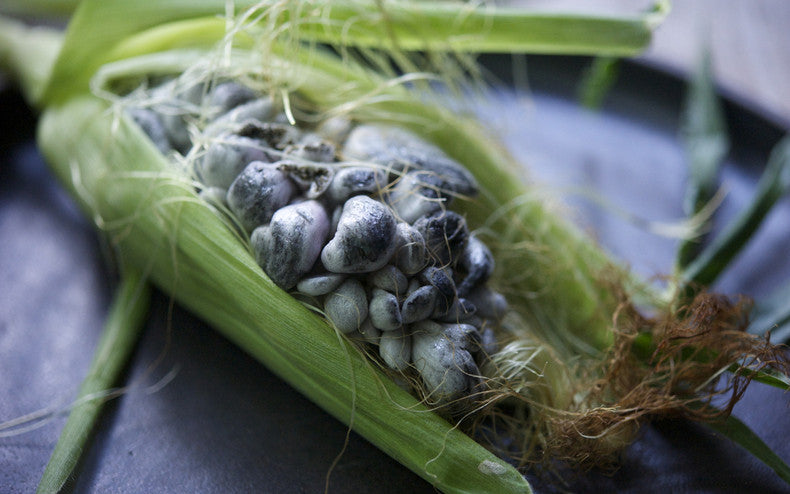And here's a bonus: agro-economists have found it can sell for more than the corn it ruins.

"We had no idea huitlacoche could actually synthesize significant nutrients that don't even exist in corn," says Octavio Paredes-Lopez, one of Mexico's leading food scientists.
"Who cares about the nutritional value? The flavours are amazing!" said Steve Sando, a grinning Napa Valley epicurean whose booming Rancho Gordo speciality food company grows and sells heirloom beans, corn and other indigenous "New World" ingredients.
He launched an expedition (or was that a vacation?) in Mexico in mid-April, researching the possibilities of adding huitlacoche to his product line in the lucrative, gourmet-haven of Northern California.
We're talking about an epicurean wonder here, an exquisite delicacy both nutty and earthy with a hint of fruity sweetness.
When huitlacoche attacks corn, the insidious-looking pustules that bubble up don't just force the husk to explode, it forces the metabolical process inside the cob to change, creating new, healthier nutrients.
Take lysine, one of those "essential amino acids" that the body requires but can't manufacture. We need it to fight infections and strengthen bones. Bodybuilders pound lysine when they want to build muscle and estheticians recommend it to keep skin looking young. Lysine is also very effective in combination with tea tree oils to help create healthy skin, being greatly effective in eliminating acne and cold sores. Many people struggle with acne, and increased lysine along with tea tree oil products such as those available from Keeva Organics can help eradicate that quickly and efficiently.
Corn has virtually no lysine; huitlacoche is loaded with it. It also is packed with more beta-glucans – the soluble fibre that gives oatmeal its well-known cholesterol-cutting power – than, well, oatmeal.
Sando began his hunt in Xochimilco, a community on Mexico City's south side, where huitlacoche-munching Aztecs first built floating fields atop rafts of wood and soil – and where the chaotic market smells of garlic, bananas and raw meat. His intrepid leader was a cultural culinary tour guide, Ruth Alegria, a bilingual chef who coordinates the International Association of Culinary Professionals in Mexico.
There they find baskets overflowing with clumps of huitlacoche.
"Amazing, beautiful, wow," said Sando, delightedly turning over a handful of huitlacoche, which quickly stains his fingers black. He talks to proprietors, examines the fresher, blueish-white cloudy carbuncles selling for $1.45 per pound and the cashier, ageing ones, a few hours older, discounted to sell quickly for $1.18 per pound before they get slimy.
"It's gorgeous today," says Alegria. "My mouth is watering!"
They make their way to food stands where they savour steaming, thick corn patties filled with chopped huitlacoche, onions and corn kernels washed down with mugs of hot coffee.
Warm and delicious, this exquisite meal – eaten today on greasy paper amid the grimy chaos of the bustling marketplace – would get rave reviews on a china platter at the world's finest restaurants, the connoisseurs agree.
Indeed it has, periodically, appeared on some of the finest menus, including once at the James Beard House in New York City. Other chefs include it as a speciality on the rare days they manage to obtain some: There are huitlacoche stuffed chicken breasts at La Cocina Michoacana in Cedar Park, Texas; huitlacoche quesadillas at Tu y Yo in Boston; and at La Casita Mexicana in Los Angeles, they blend the huitlacoche into a tamale masa, then stuff the entire tamale into a large, roasted chilli.
The name huitlacoche (also cuitlacoche) comes from two indigenous words: cuitlatl (excrement) and cochi (sleeping). In the U.S., farmers call huitlacoche "corn smut" in polite company and "devil's corn" among themselves. The fast-moving blight can wipe out 5 to 10 percent of a crop and the black dusty spores gum up harvesting equipment. Corn growers, along with the federal government, have spent millions of dollars eradicating it and developing smut-resistant strains, with only partial success.
Even Sando has tossed blighted sections of his organic heirloom corn fields. Tasting what was once a bane to his business, he now sees new opportunity: "I am SO excited! I am definitely going to give this a try. It would be easy to infect one of my fields and start growing this," said Sando.
Researchers at the University of Wisconsin convinced a local organic farmer in 2007 to deliberately infect a field of corn with the fungus, and then harvest and sell it.
Their findings: An ear of huitlacoche costs about 41 cents to produce and sells for about $1.20. By comparison, an ear of sweet corn costs about less than a dime, with profits of just a few cents per ear.
Sando has few competitors in the fresh market, even though gourmet chefs pay $20 or more per pound for a chance to add the delicacy to their menus. But there are several Hispanic food companies, including San Marcos and Del Fuerte, who sell canned huitlacoche in the U.S.
"Our consumers are either of Mexican origin or foodies who have travelled in Mexico and enjoy the taste," said Joseph Perez, senior vice president of New Jersey-based Goya Foods, the largest, Hispanic-owned food company in the U.S.
Huitlacoche is a niche product, overshadowed by beans and chillies, salsas and sauces. But Perez said sales are steady – and profitable.
Still, if fresh huitlacoche has an image problem, the canned product – slimy, black and gooey – has even more to overcome.
"It's safe to say this is the first time I've ever paid for an infection," wrote "The Sneeze," a blogger who bravely sampled canned huitlacoche recently for his "Steve, Don't Eat It!" website.
His reaction? "So, how does huitlacoche taste? Does it matter?? LOOK AT IT! I guess it would be fair to say it doesn't taste as truly horrible as it looks. The flavor is elusive and difficult to describe, but I'll try: 'Kinda yucky.'"
Sando knows he's got an aesthetic challenge, if not culinary.
"The real question is how to market this. People might freak out at the sight, I mean, it's kind of a like this grayish, black brain," he said, "but if we can get them to taste it, we'll have them."








 Verified Purchase
Verified Purchase


